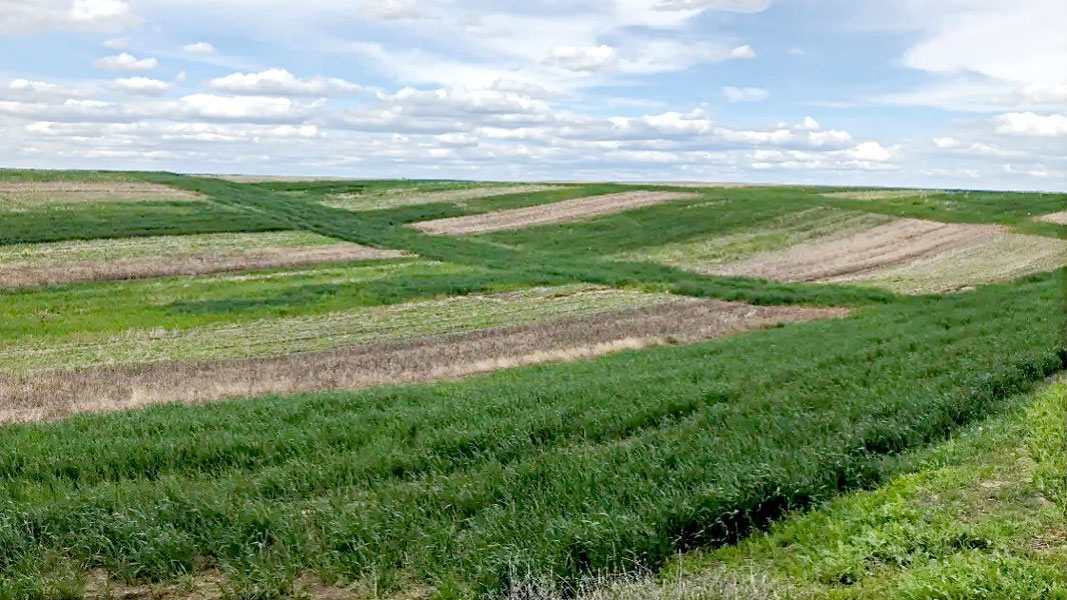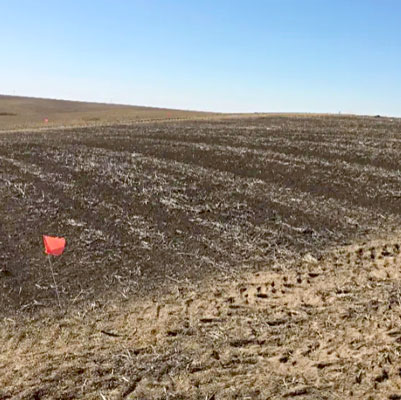Top: A photo of the field trial field in the spring where visual differences between the treatments is very noticeable. Photo courtesy Burke Lab
Washington State University (WSU) researchers, Drs. Shikha Singh and Ian Burke, have been conducting what they think is the longest-running compost application trial in dryland wheat systems to help inform dryland wheat producers about the rates necessary for effective compost applications. In a recent article, Singh and Burke describe the scope of the project and results to date. “Despite the direct and indirect benefits of applying compost to soils, its adoption among dryland wheat farmers is not very popular yet for three primary reasons — transportation cost, lack of research in dryland wheat cropping systems, and compost quality,” they explain. “It costs money to move anything from one location to another, and the dryland farmers in rural Eastern Washington must foot the bill to get the compost to their fields. This can get pricy, especially when you add to the cost of the compost itself.” Rigorous compost testing, and ongoing research projects like theirs at WSU, are helping to address the situation, explain Singh and Burke. To help offset the cost, producers can receive reimbursement for up to 50% of their compost costs through the Washington State Department of Agriculture.
The field site where the compost application research is being conducted has silt loam soils, uses no-till dryland wheat-based rotation, and receives 13 inches of annual precipitation (much of which comes in the winter months). Seven years ago, in Fall 2016, four different rates of compost were applied: 0, 4, 10, and 20 tons per acre. A control was also established where typical fertilizer rates were applied. The compost was sourced from a composting facility in Spokane. “These different rates of compost were evaluated under two cropping systems: Winter wheat/Chemical (Chem) fallow and Winter wheat/Chem fallow/Winter pea/Chem fallow, which are both typical rotations of the dryland farmers in the region,” write Singh and Burke. “The winter wheat cultivar used in this study is Otto. To evaluate the effect of each rate of compost, winter wheat yield and quality data were collected, and soil samples were collected and analyzed for soil nutrients.
“But the most interesting results have come from the wheat yield and soil moisture. The farmers in the region typically use a fallow, or a time when a field is not growing a crop, to help preserve soil moisture for the subsequent cash crop. This study showed that seven years after the compost applications, soil moisture levels are higher where the compost was applied, especially at the highest application rate (20 tons/acre). We think this could be due to the mulching effect of the compost.”
In both crop rotations, wheat yields have been stable, but the highest rate of compost (20 tons/acre) has shown the highest yields in most years since 2016. “One thing to keep in mind is that none of the areas treated with compost received external fertilizers — which means that the compost is supplying sufficient essential crop nutrients, resulting in the highest yields,” states the article. “With the large amounts of compost being applied, you might expect to see increases in soil organic matter. One of the tricky things about soil organic matter is that it takes time to increase. The microbes in the soil, while working diligently, can only stabilize the components in the compost that will eventually make up soil organic matter so quickly. There is an upward trend with the highest application rate (20 tons/acre), but it is not statistically significant.” The article includes wheat yield and soil moisture data from the study.














